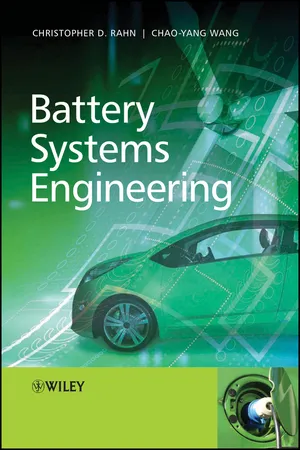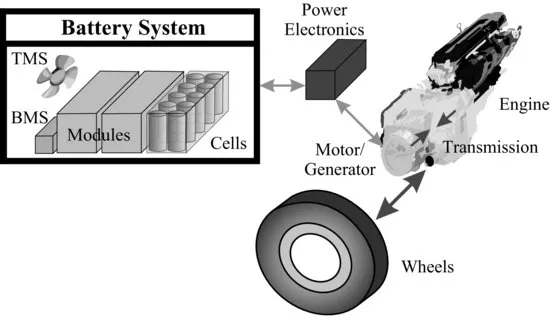![]()
1
Introduction
High energy costs drive the development of power systems with increased efficiency and effectiveness. One way to increase performance is to store energy that cannot be used at the time of its production. Batteries are being used in hybrid vehicles and renewable energy applications for this purpose. These applications can require dynamic cycling of the battery that can lead to poor performance and premature aging if not controlled by a sophisticated battery management system (BMS). BMSs that are based on accurate system models hold great promise for extending the life and increasing the performance of energy storage systems. This chapter motivates the need for model-based battery system engineering and introduces the electrochemistry and design of battery cells and packs.
1.1 Energy Storage Applications
Energy storage is vitally important to many applications, ranging from small-scale portable electronics to large-scale renewable energy sources. Portable electronic devices that use batteries include video/audio players, medical equipment, power tools, meters and data loggers, and remote sensors [1]. In these applications, batteries free the user from power cords and enable portable use. The batteries in these devices are discharged over time and then recharged periodically. Energy storage can also be used in large-scale applications to reduce oil, gas, and coal consumption. Hybrid vehicles for ground transportation and renewable (e.g., wind and solar) energy sources make use of batteries to store energy that cannot be used at the time of its production. The charge and discharge cycles in these applications are more frequent and dictated by the variable power supply and demand.
To increase the fuel efficiency of ground vehicles, batteries are being used to supplement and sometimes replace the power provided by liquid fuel. Figure 1.1 shows four pioneering vehicles that use batteries to increase fuel efficiency and performance. The Toyota Prius in Figure 1.1a is a hybrid electric vehicle (HEV). It uses a nickel–metal hydride (Ni–MH) battery pack manufactured by Panasonic. The Nissan Leaf and Tesla Roadster in Figure 1.1b and d, respectively, are electric vehicles (EVs). The Leaf uses a laminated lithium-ion (Li-ion) battery pack developed by Nissan–NEC and the Tesla uses a specially built pack with thousands of 18650 (18 mm diameter and 65 mm long) Li-ion cells. The Chevy Volt in Figure 1.1c is a plug-in HEV (PHEV) or extended-range electric vehicle (EREV) that has a Li–polymer battery pack supplied by LG-Chem.
HEVs are commanding a growing share of the passenger car, truck, and bus markets. Hybrid powertrains consist of an internal combustion engine (ICE), powertrain, electric motor, and batteries. HEVs conserve energy because they have the ability to:
1. Eliminate engine idling. The engine stops when the vehicle is stationary.
2. Recover and store energy. The electric motor is used as a generator to brake the vehicle. The regenerated energy is stored in the batteries.
3. Boost power. The electric motor and engine work together to increase torque during acceleration.
4. Operate efficiently. The engine can be run at its most efficient speed and the electric motor can provide power during off-peak operation.
HEVs vary in cost and complexity from simple retrofits to complete redesigns of existing ICE vehicles. Micro hybrids use a higher power starter/alternator to provide the advantages of eliminating engine idling. Soft hybrids add some regenerative braking and low-speed movement under electric power. Mild hybrids insert an electric motor/generator into the drive axle to provide all of the benefits of hybrid operation. The parallel drive train often used in mild hybrids allows the electric motor/generator to run the vehicle and boost power at low speeds. Full hybrids often use a series/parallel drive train that has all of the benefits of the parallel drive train. They can be used to decouple the motor speed from the vehicle speed so that the motor can run more often at peak efficiency. Full hybrids are the most efficient and complicated HEVs, with the batteries carrying a larger percentage of the load, continually being charged and discharged.
The battery packs in PHEVs charge directly from the electric grid and run the vehicle for a distance in pure electric mode with zero gas consumption and emissions. The vehicle also has an ICE that can be used to extend the electric-only range or increase the speed above the electric-only limit. After the batteries have been depleted to a specified level, the vehicle operates in full hybrid mode until it can be fully recharged from the grid. The Chevrolet Volt PHEV uses a variation on the series drivetrain where the engine drives a generator and is not mechanically connected to the drive wheels. A series drivetrain cannot use the engine and electric motor simultaneously to provide a power boost for quick acceleration.
EVs are zero-emission vehicles that charge from the grid. Batteries provide all of the power and energy for the drive motor. The key consideration in the design of an EV is the weight and cost of the battery pack. Lighter weight batteries typically cost more. The batteries are charged and then slowly discharged during operation, with regenerative braking providing intermittent recharge pulses.
The charging infrastructure required for EVs is a major challenge to the widespread adoption of this technology. Chargers at home or work can take hours to charge the battery for an EV or PHEV without too much inconvenience to the driver. If an EV is on the road and needs a quick charge, however, the infrastructure for fast (5 min) charging should be widely available. The charging power for a 5 min charge is 12 times the power that the pack can provide for 1 h. Long-range (300 mi) EVs require roughly a 75 kWh pack, so a 5 min charge would require 0.9 MW from the grid. As more and more EVs with longer and longer ranges replace gas-powered vehicles, the power grid infrastructure will need to drastically increase to accommodate the increased demand.
Passenger cars make up the bulk of the HEV market, but trucks and buses have also been converted to HEVs and EVs. Figure 1.2 shows, for example, an all-electric switchyard locomotive developed by Norfolk Southern. The locomotive is charged during the night and then is used for an 8 h shift, moving freight cars around the yard to form trains. Over 1000 lead–acid (Pb–acid) batteries are used to power the electric traction motors.
Renewable energy sources such as wind and solar and smart-grid technology require energy storage to buffer power production deficits. Wind and solar energy sources do not produce energy at a continuous rate. Energy produced in excess of demand can be stored in large-scale battery farms to be used at a later time. Home energy storage can reduce costs by taking grid power during low-demand periods (e.g., at night) and reducing grid power during high-demand periods. A smart grid regulates the power delivered to individual homes so that household energy storage can bridge the power gaps.
1.2 The Role of Batteries
There are many ways to store energy (e.g., flywheels, ultra-capacitors, and compressed air), but batteries are the best choice for most applications. Batteries can be scaled from small (cell phone), to medium (HEVs), to large (grid) applications. They are highly efficient and have high energy-to-weight ratios. They are safe and often recyclable. Cost and battery life, however, are concerns that prevent more widespread application of batteries for energy storage applications. Researchers are continually inventing lower cost and longer life battery chemistries. As batteries become integral parts of high-volume products, economies of scale will reduce costs. A life-extending BMS, designed using the techniques described in this book, ensures that the battery pack is being used in a most efficient and cost-effective manner.
1.3 Battery Systems Engineering
Battery systems engineering sits at the crossroads of chemistry, dynamic modeling, and systems engineering. Battery chemists/engineers understand the electrochemistry and materials issues required to design batteries but may not have the background to address the complex mathematical modeling and control systems design associated with efficient battery management algorithms. Mathematical modelers can develop accurate models of battery cells but these models are often not easily adopted for systems engineering. Systems engineers have the controls and dynamics background to analyze, design, and simulate the system response but may not understand the underlying chemistry or models.
One of the main objectives of this book is to bring batteries into the realm of systems engineering. From a systems engineering perspective, battery packs are multi-input, multi-output systems. The primary input, current, is prescribed by the supply and demand from the powered device. The primary output is the battery voltage. Other outputs include temperature, individual battery or cell voltages, and ionic concentration distributions within a given cell. Systems engineers need cell, battery, and pack models in standard (e.g., state variable and transfer function) forms that can be used to predict, estimate, and control these outputs.
The dynamic environment of many energy storage applications requires advanced BMSs. BMSs are often concerned with charging protocols because applications require fully charging the pack at periodic intervals. The battery-powered device (e.g., laptop) then draws low current, slowly discharging the pack until it is time to recharge again. An HEV, on the other hand, requires fast and high-current energy storage associated with dynamic acceleration and braking of the vehicle. Figure 1.3 shows, for example, two HEV battery cycling profiles. The power into and out of the battery pack changes quickly over the 6 min cycles. This rapid charge–discharge cycling of the battery pack requires sophisticated BMSs to regulate the current in and out of the pack in real time. An effective BMS sets the current limits low enough to maximize the battery life and ensure safety but high enough to maximize power output.
Figure 1.4 shows a schematic diagram of the electromechanical system of an HEV. The battery system consists of cells grouped into modules that make up the battery pack, the BMS, and the thermal management system. The power electronics interface the battery system to the motor/generator that is mechanically coupled to an ICE through a transmission. The power electronics typically include high-power switching circuits, inverters, DC–DC converters, and chargers. The transmission either connects both the motor/generator and the engine to the wheels (parallel configuration), only the motor/generator to the wheels (series configuration), or some combination of the two (hybrid configuration).
While there are significant challenges in the development of new battery chemistries, power electronics, and motor/generators for HEV/PHEV/EV application, the focus of this book is on the dynamics of commercially available cells/packs and the development of estimation/control software that runs on-board the vehicle. The dynamic models can be used to simulate and optimize the system response. The software is based on the developed models and predicts and controls the battery-pack response to optimize performance and long pack life. Batteries are the highest cost item in HEV, PHEV, and EV powertrains, so their optimal utilization is paramount to the development of affordable vehicles.
1.4 A Model-Based Approach
Batteries can be designed using empirical or model-based approaches. In an empirical approach, cells are built and tested for performance. Based on the results of the tests, the batteries are redesigned and tested again. This is a time-consuming and expensive process. In a model-based approach, a model is used to predict performance based on the battery design. This process is termed computer-aided engineering (CAE) because the battery can be designed and optimized relatively quickly on a computer. Model-based design ensures that the batteries developed have the highest possible performance, making them competitive in the marketplace.
A model-based approach builds upon a fundamental physics-based model that predicts the battery response. The model starts with the electrochemical and physical partial differential equations (PDEs) that...




